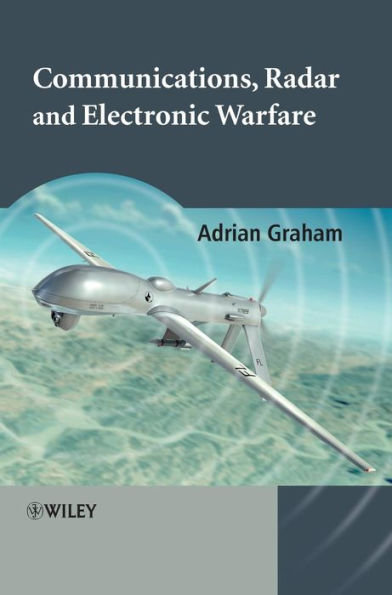Communications, Radar and Electronic Warfare / Edition 1 available in Hardcover, eBook

Communications, Radar and Electronic Warfare / Edition 1
- ISBN-10:
- 0470688718
- ISBN-13:
- 9780470688717
- Pub. Date:
- 01/25/2011
- Publisher:
- Wiley

Communications, Radar and Electronic Warfare / Edition 1
Buy New
$144.95Overview
In this book, the author covers both the civilian and military uses of technology, focusing particularly on the applications of radio propagation and prediction. Divided into two parts, the author introduces the basic theory of radio prediction before providing a step-by-step explanation of how this theory can be translated into real-life applications. In addition, the book presents up-to-date systems and methods to illustrate how these applications work in practice. This includes systems working in the HF bands and SHF. Furthermore, the author examines the performance of these systems, and also the effects of noise, interference and deliberate jamming, as well as the performance of jamming, detection and intercept systems. Particular attention is paid to the problems caused by Radio Controlled Improvised Explosive Devices (RCIEDs).
Key Features:
- A practical handbook on the topic of radio communications and propagation
- Written by an expert in both the civilian and military applications of the technology
- Focuses on methods such as radio and radar jamming, and radio-controlled improvised explosive devices (IEDs)
- Contains problems and solutions to clarify key topics

Product Details
| ISBN-13: | 9780470688717 |
|---|---|
| Publisher: | Wiley |
| Publication date: | 01/25/2011 |
| Pages: | 400 |
| Product dimensions: | 6.80(w) x 9.80(h) x 1.00(d) |
About the Author
Table of Contents
Preface.Glossary.
PART ONE – BASIC THEORY.
1 Introduction.
1.1 The Aim of this Book.
1.2 Current Radio Technology.
1.3 Factors Constraining Radio Communications.
References and Further Reading.
2 Management of the Radio Spectrum.
2.1 Spectrum Management Fundamentals.
2.2 Civil Spectrum Management.
2.3 Military Spectrum Management.
2.4 Management of EWActivities.
References and Further Reading.
3 The Radio Channel.
3.1 Frequency Aspects of the Radio Channel.
3.2 Narrowband Signals.
3.3 Frequency Hopping Signals.
3.4 Wideband Signals.
3.5 The Effect of Movement on the Radio Channel.
References and Further Reading.
4 Radio Links in the Presence of Noise.
4.1 Sources of Radio Noise.
4.2 Effects of Noise.
4.3 The Radio Receiver.
4.4 Radio Link Budgets in the Presence of Noise.
References and Further Reading.
5 Radio Links in the Presence of Interference.
5.1 Sources of Radio Interference.
5.2 Interference in the Spectral Domain.
5.3 Interference in the Time Domain.
5.4 Interference Mitigation Techniques.
References and Further Reading.
6 Radio Links and Deliberate Jamming.
6.1 The Purpose of Jamming.
6.2 How Jamming Works.
6.3 Types of Communications Jammers.
6.4 Jamming Mitigation Techniques.
References and Further Reading.
7 Radar and Radar Jamming.
7.1 Introduction to Radars.
7.2 The Radar Equation.
7.3 Types of Radar.
7.4 Radar Jamming Techniques.
7.5 Radar Jamming Mitigation Techniques.
References and Further Reading.
8 Radio-Controlled Improvised Explosive Devices.
8.1 The Poor Man’s Weapon of Choice: IEDs.
8.2 Radio Control for IEDs.
8.3 Detection of IED Radio Control Systems.
References and Further Reading.
PART TWO – PRACTICAL.
9 Predicting HF Radio.
9.1 Propagation at HF.
9.2 HF Skywave Link Budgets.
9.3 Groundwave.
References and Further Reading.
10 VHF to SHF Radio Prediction.
10.1 Propagation above HF.
10.2 Modelling Methods.
10.3 Deterministic Models.
10.4 Empirical Models.
10.5 Combined Models.
10.6 Link Budgets.
References and Further Reading.
11 Data Requirements for Radio Prediction.
11.1 Why Consider Modelling Requirements?
11.2 Communications System Parameters.
11.3 ES Specific Parameters.
11.4 EA Specific Parameters.
11.5 Radar Specific Parameters.
11.6 Third-Party Characteristics.
11.7 General Antenna Characteristics.
11.8 Antenna Environment Considerations.
11.9 Terrain Data.
11.10 Ground and Radio Clutter Data.
11.11 Sunspots, Ionospheric and Atmospheric Data.
References and Further Reading.
12 Planning and Optimising Radio Links.
12.1 Path Profile Prediction.
12.2 Optimising a Link.
12.3 Re-Broadcast Links.
12.4 Linked Networks.
References and Further Reading.
13 Planning Radio Networks for Coverage.
13.1 Coverage Predictions.
13.2 Optimisation of Radio Networks.
13.3 Limiting Coverage.
References and Further Reading.
14 Interference Analysis.
14.1 Introduction to Radio Interference Analysis.
14.2 Fading Considerations.
14.3 Interference from other Channels.
14.4 Different Ways of Representing Co-Existing Signals.
References and Further Reading.
15 Management Techniques for Interference.
15.1 Preventing Interference.
15.2 Managing Interference.
15.3 Interference Reports.
References and Further Reading.
16 Management of Interference at a Radio Site.
16.1 Special Features of Radio Sites with Multiple Systems.
16.2 Sources of Interference at a Radio Site.
16.3 Methods of Managing Interference at Radio Sites.
References and Further Reading.
17 Communications Electronic Warfare.
17.1 Introduction.
17.2 Detection and Intercept Networks.
17.3 Direction Finding Networks.
17.4 Communications Jammers.
17.5 The Role of Unmanned Airborne Vehicles.
17.6 Countering Enemy Communications Electronic Warfare.
References and Further Reading.
18 Non-Communications Electronic Warfare.
18.1 Non-Communications EW.
18.2 Radar Jamming Techniques.
18.3 Platform Self Protection Methods.
18.4 Parametric Information Collection Methods.
References and Further Reading.
19 Countering Radio-Controlled IEDs.
19.1 Introduction to IEDs.
19.2 Radio Controlled IED.
19.3 Basic IED Counter Methods.
20 Summary and Conclusions.
Appendix A: Working with Decibels.
Appendix B: Common Conversion Formulae and Reference Tables.
Index.
